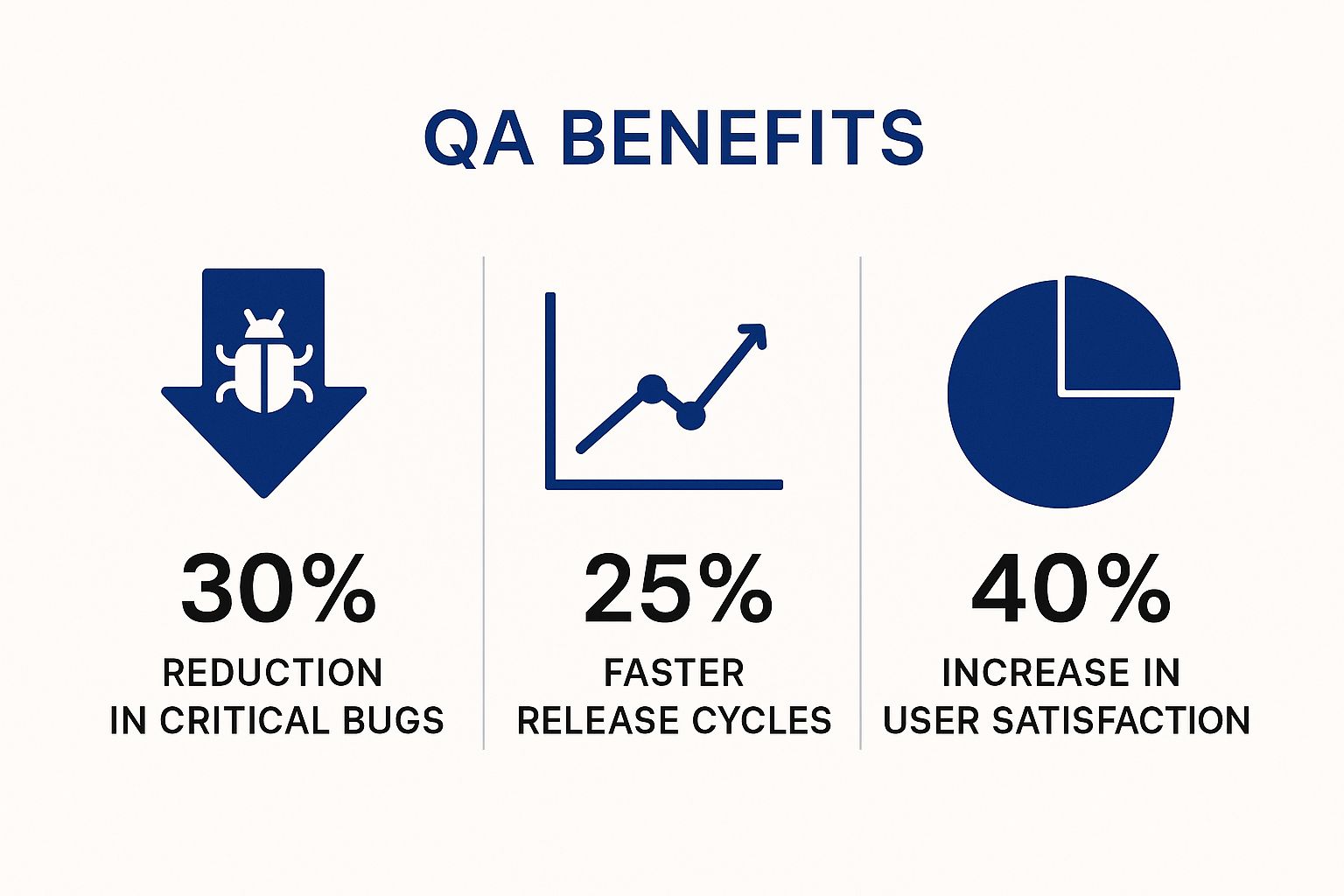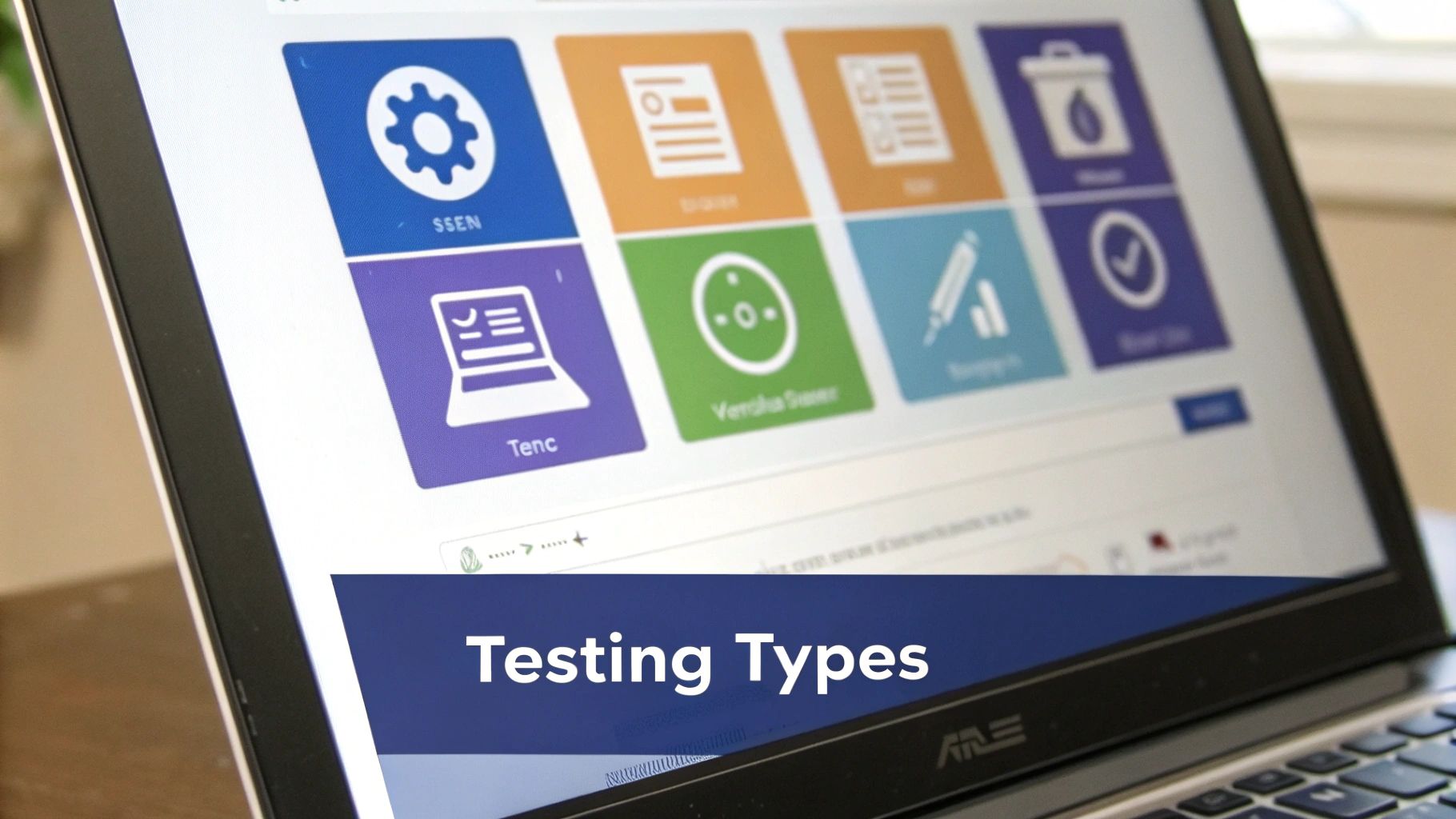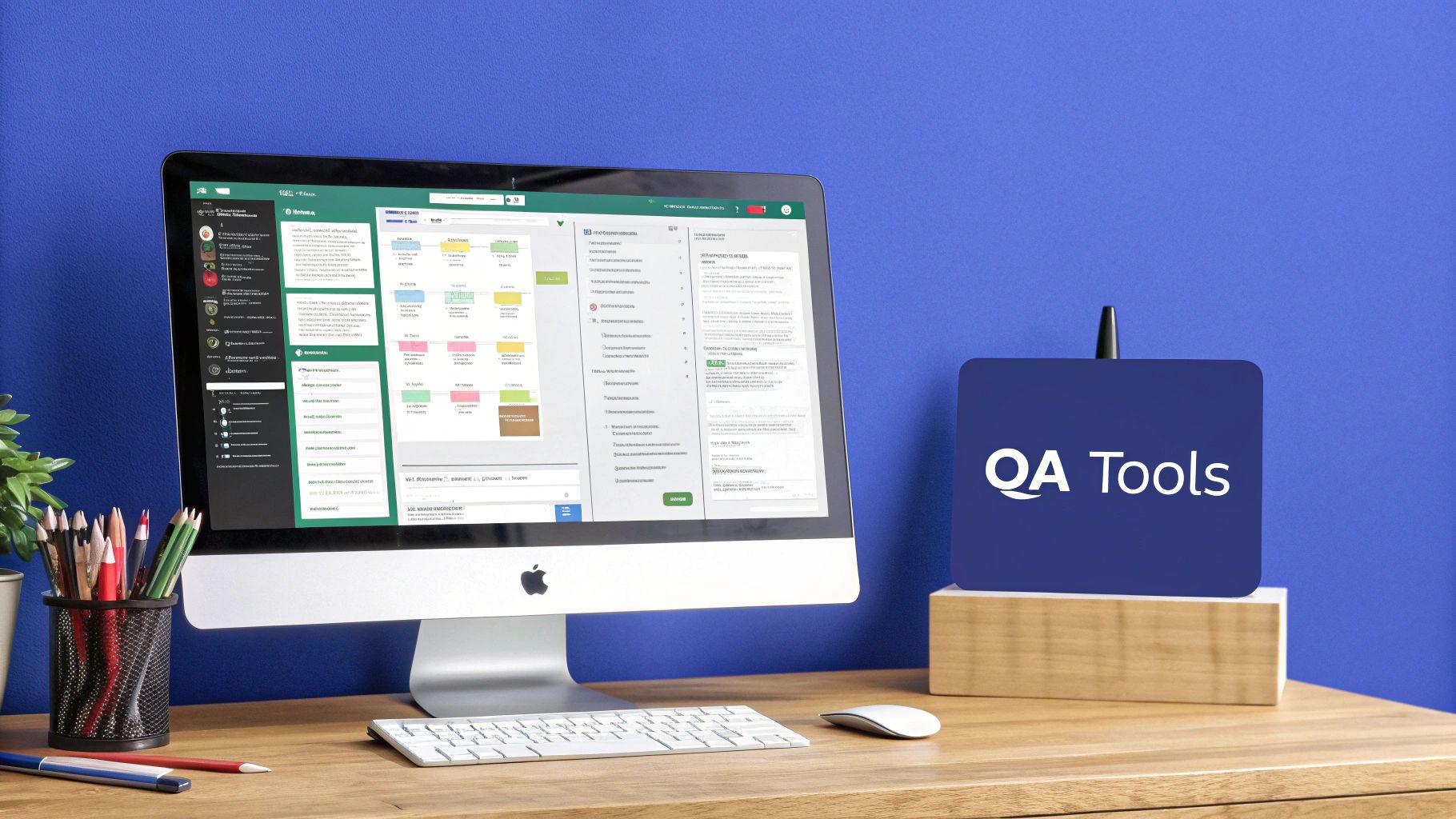Building Your Foundation: What Makes QA Testing Actually Work

Effective website quality assurance testing isn't simply about uncovering existing bugs. It's about establishing a robust system that prevents them from ever surfacing. This proactive strategy demands a well-defined plan, transparent communication, and a dedication to quality throughout every phase of development. It means shifting from mere checklists to embracing testing as a crucial strategic advantage.
Key Principles of Effective QA
High-performing QA teams prioritize key principles. First, they establish clear testing protocols. These protocols detail the types of tests employed, their frequency, and the pass/fail criteria. This standardization ensures consistent results and reduces the risk of overlooking critical problems.
Effective teams also cultivate open communication between developers, testers, and stakeholders. This collaborative approach ensures everyone is aligned on quality expectations and potential risks.
For example, a robust protocol might mandate that every new feature undergoes both automated testing with a tool like Selenium and manual testing before release. Automated tests efficiently verify basic functionality, while manual testing delves into more complex user scenarios and edge cases.
This multi-layered approach ensures comprehensive coverage. Regular communication helps identify and resolve potential conflicts early, further streamlining the development process.
The Importance of a Structured Testing Framework
A structured testing framework is the cornerstone of successful QA. It provides a roadmap for all testing activities, guaranteeing thorough coverage of potential weaknesses. This framework also enables efficient resource allocation, maximizing the impact of testing and eliminating wasted effort.
A well-designed framework typically incorporates various testing methodologies, including functional testing, performance testing, and usability testing.
Functional testing confirms that each feature operates as intended. Performance testing evaluates the website's speed, stability, and scalability under various load conditions. Usability testing centers on user experience, ensuring the website is intuitive and easily navigable.
These distinct testing types, integrated within a structured framework, form a comprehensive safety net. They effectively catch a broad range of potential issues before they impact users. Website quality assurance is becoming increasingly vital as organizations invest heavily in delivering high-quality software. By 2025, QA is projected to account for approximately 40% of overall development budgets. For more insights on this trend, see these Software Testing Statistics.
Aligning Testing with Business Priorities
Finally, effective website quality assurance testing must directly align with overarching business objectives. This alignment focuses testing efforts on the areas most crucial to the organization and its users.
For instance, an e-commerce website might prioritize testing its checkout process. This ensures a smooth and secure buying experience, minimizing lost sales and bolstering customer trust. Consider these insights on quality assurance best practices for further guidance.
By aligning testing with business goals, QA teams transform into strategic partners. They become instrumental in driving success and contributing to the bottom line.
The Automation Revolution: Where Machines Excel And Humans Win
The software development world is abuzz with talk of automation, and rightly so. Automated website quality assurance testing offers incredible potential for increased efficiency, empowering teams to develop faster and test more comprehensively. But it's not a simple matter of setting it up and walking away. True success comes from a powerful synergy: the collaboration of human expertise and automated tools.
Strategic Automation: Maximizing ROI in QA
Leading companies aren't simply automating every test. They're strategically selecting tests that offer the greatest return on investment when automated. Repetitive tasks like regression testing, where you're verifying existing functionality after code changes, are perfect examples. This frees up human testers to concentrate on exploratory testing, usability evaluations, and those tricky edge cases that demand creative thinking and a nuanced understanding of real-world scenarios.
Automated tests also shine at swiftly identifying simple bugs and inconsistencies across various browsers and devices. This speed is essential in today's rapid development cycles, enabling quicker feedback loops and faster releases.
However, not all tests are created equal. Certain areas, such as user experience testing, still heavily rely on human intuition and judgment. A machine can't tell you if a design feels intuitive or a workflow is logical. This is where human testers excel, providing invaluable feedback that elevates the overall user experience.
To understand the impact of a balanced automation approach, let's look at the following comparison:
Introducing the "Manual vs Automated Testing Comparison" table. This table provides a comprehensive comparison of manual and automated testing, highlighting their benefits, limitations, and ideal use cases.
| Testing Aspect | Manual Testing | Automated Testing | Best Use Case |
|---|---|---|---|
| Test Case Design | Requires human understanding and intuition | Relies on predefined scripts and data | Complex scenarios vs. Repetitive tasks |
| Execution Speed | Slower, requires human intervention | Significantly faster, runs unattended | Rapid feedback cycles |
| Cost | Higher labor costs, especially for repetitive tests | Higher initial investment, lower long-term cost | Long-term projects with frequent regression testing |
| Accuracy | Prone to human error | Highly accurate for predefined steps | Data validation and repetitive tasks |
| Flexibility | Highly adaptable to changing requirements | Less flexible, requires script modifications | Exploratory testing and usability evaluations |
| User Experience | Excellent for evaluating usability and intuitiveness | Limited ability to assess subjective qualities | User interface and user experience testing |
As the table illustrates, manual and automated testing each have their strengths. Choosing the right approach, or a combination of both, depends on the specific testing needs.

This infographic further emphasizes the impact of strategic automation, demonstrating how it can result in a 30% reduction in critical bugs, 25% faster release cycles, and a 40% increase in user satisfaction.
Navigating the Transition to Automation
Shifting from primarily manual testing to a balanced automation strategy demands meticulous planning and execution. Teams must identify the right tools, cultivate automation skills, and adapt their workflows. It can be a challenging undertaking, but the rewards are substantial. For a solid foundation, consider established software quality assurance best practices.
One crucial challenge is selecting the appropriate automation tools. The market offers a wide array of choices, each with its own advantages and disadvantages. Teams should carefully evaluate these tools, considering factors like ease of use, integration capabilities, and support for various testing types. A popular choice is Selenium.
Equally crucial is developing the team's skill set. Testers need to acquire proficiency in scripting, test automation frameworks, and tool maintenance. This often involves training existing team members and potentially bringing in new talent with specialized automation expertise. The adoption of test automation is rapidly growing. By 2025, AI testing adoption grew from 7% in 2023 to 16%, and automation replaced 50% or more of manual testing for 46% of teams. More detailed statistics can be found here.
Building a Sustainable Automation Strategy
Implementing automation isn't a one-time project; it's an ongoing journey. Teams need to establish clear procedures for creating, maintaining, and updating automated tests, ensuring they remain relevant and effective as the website evolves.
Moreover, successful automation hinges on close collaboration between developers and testers. Developers must write testable code, while testers must provide feedback on automation opportunities and address challenges. This collaborative approach ensures alignment between automation efforts and overarching development goals. By strategically integrating automation, building team expertise, and implementing sustainable practices, organizations can truly unlock the full potential of website quality assurance testing. This translates to higher quality software, faster release cycles, and ultimately, more satisfied users.
Modern QA Tools That Are Actually Worth Your Investment

The world of website quality assurance testing is constantly changing. New tools are always emerging. But are they all worth the hype? This section explores the technologies truly impacting testing, empowering you to make smart investment choices for your QA team.
Low-Code Platforms: Democratizing Test Automation
A significant trend is the rise of low-code platforms. These platforms allow team members without deep coding skills to participate in automated testing. This democratization of testing is invaluable. It fosters broader involvement in quality assurance and improves team collaboration.
Some platforms utilize visual interfaces, allowing users to create automated test scripts through simple drag-and-drop actions. This eliminates the need for dedicated coding resources, maximizing efficiency and expanding test coverage.
This streamlined approach also accelerates test creation and modification, making QA processes more agile and responsive to changing project needs. Further enhancing their value, low-code platforms are increasingly integrating with other development pipeline tools for a more seamless testing experience.
Cybersecurity Integration: A Non-Negotiable Aspect of Modern QA
With the increasing complexity of cyber threats, incorporating cybersecurity testing into website QA is no longer optional. Modern tools are evolving to include features that identify vulnerabilities and protect sensitive data.
This integrated strategy addresses a crucial element of website performance, ensuring both functionality and security from the start. This focus is paramount for maintaining user trust and safeguarding sensitive information.
The growing adoption of low-code platforms and the heightened focus on cybersecurity are reshaping the website QA landscape. By 2025, these platforms are projected to address skill gaps and elevate team collaboration. Learn more about evolving testing practices and explore the upcoming software testing trends.
Building a Synergistic Tool Stack
Selecting the right tools for your team and website is crucial. A poorly designed tool stack can actually hinder, not help, efficiency. When evaluating the role of automation, review established automation testing best practices. Prioritize tools that integrate seamlessly with your existing workflows and address your specific testing requirements.
Start by pinpointing your current testing challenges. Where can automation make the most significant impact? Look for tools that align with your team's skills and offer comprehensive support and documentation.
For instance, if your site relies heavily on dynamic content, explore tools specializing in JavaScript and API validation. If cross-browser compatibility is a priority, choose platforms offering automated testing across various browsers and devices.
Assessing Tool Effectiveness: Measurable Improvements
Evaluating tool effectiveness requires more than just believing marketing hype. Concentrate on measurable improvements such as reduced testing time, quicker identification of critical bugs, and tighter alignment between QA and development.
Many tools provide in-depth reporting and analytics to offer valuable insights into testing progress and pinpoint areas for optimization. These metrics provide a data-driven approach to assessing the genuine impact of your tools on website quality. By consistently tracking these indicators, you can optimize your tool stack and ensure your QA investment delivers real results.
Tailoring QA Strategies For Different Website Types
Effective website quality assurance testing demands a tailored approach. Generic strategies simply won't cut it. Different websites have unique vulnerabilities and user expectations. A truly robust QA strategy recognizes these nuances and adapts accordingly. This means understanding the specific failure points of various website types and applying targeted testing protocols.
E-commerce Platforms: Focusing on Conversions
For e-commerce sites, the checkout process reigns supreme. Any friction in this critical area directly impacts sales. Functional testing of the entire purchase funnel, from product selection to payment confirmation, is paramount. Imagine losing a customer at the final step due to a glitch! Performance testing under high-traffic conditions is equally vital. Site slowdowns during peak shopping periods can lead to significant revenue loss. Robust security testing to protect sensitive customer data is absolutely non-negotiable. Don't risk your customers' trust!
Additionally, e-commerce sites often benefit from A/B testing different checkout designs or promotional offers to optimize conversion rates. This data-driven approach ensures that QA efforts directly contribute to business goals.
Content-Heavy Websites: Prioritizing Accessibility and SEO
Websites focusing on content delivery, such as blogs or news sites, prioritize different aspects of QA. Ensuring content is accessible across various devices and browsers is crucial for reaching a wide audience. SEO best practices must be considered to maximize search engine visibility. Performance testing, focusing on page load speeds, is critical as slow loading times can deter readers and negatively impact search rankings.
Broken links and outdated information can damage credibility. Regular content audits should be an integral part of the QA process. Usability testing can identify navigation issues, ensuring readers can easily find the content they seek.
Interactive Web Applications: Emphasizing Functionality and User Experience
Web applications, with their interactive elements and complex functionalities, demand a rigorous QA approach. Functional testing becomes especially important to ensure all features operate as intended. Usability testing is key for a positive user experience. Given that web applications often handle sensitive data, security testing is mission-critical. Performance testing, especially under varying load conditions, is essential for guaranteeing responsiveness and stability.
Building a Tailored QA Framework
Crafting a customized QA strategy requires careful consideration of your website's specific characteristics. Start by analyzing user behavior data to understand how visitors interact with your site. Conduct a thorough business risk assessment to identify potential failure points and prioritize testing efforts accordingly.
Consider the technical complexity of your website. More complex sites often require more sophisticated testing tools and techniques. Gaining valuable user feedback is essential for ensuring positive user experiences and maximizing conversion rates. A helpful resource can be found here: How to master website design feedback.
The following table, "Website Type Testing Priority Matrix," provides a general framework for prioritizing QA efforts based on website type, outlining critical testing areas, priority levels, and recommended tools. It will help you focus your QA efforts where they matter most.
| Website Type | Critical Testing Areas | Priority Level | Recommended Tools |
|---|---|---|---|
| E-commerce | Functional Testing (Checkout Process), Performance Testing (High Traffic), Security Testing | High | Selenium, JMeter, OWASP ZAP |
| Content-Heavy | Accessibility Testing, SEO Testing, Performance Testing (Page Load Speed), Content Audits | Medium | BrowserStack, Semrush, WAVE |
| Web Application | Functional Testing, Usability Testing, Security Testing, Performance Testing (Varying Load) | High | Selenium, UserTesting, OWASP ZAP, JMeter |
This matrix highlights the essential testing areas for each website type, guiding you towards a more effective QA strategy. By understanding these nuances and implementing a tailored QA strategy, you can ensure your website meets the highest standards of quality, performance, and user experience. This targeted approach optimizes resource allocation and maximizes the impact of your website quality assurance testing efforts. Invest wisely in QA, and reap the rewards of a high-performing, user-friendly website.
Making Continuous Testing Work In Real Development Environments

Continuous testing—the frequent, automated assessment of website quality throughout the development lifecycle—offers immense benefits. Implementing it effectively, however, requires a strategic approach that seamlessly integrates with your existing workflows. This section explores proven strategies for embedding website quality assurance testing within your development processes, creating rapid feedback loops, and enabling your team to address issues quickly and cost-effectively.
Shift-Left and Shift-Right: Balancing Early Detection With End-to-End Validation
Top-performing development teams often employ a combination of shift-left and shift-right testing methodologies. Shift-left prioritizes early and frequent testing, integrating quality assurance from the very beginning of the development process. This proactive approach helps identify and address potential issues before they become major problems, saving valuable time and resources down the line.
Shift-right, conversely, focuses on testing in production-like environments and gathering user feedback after release. This real-world validation complements shift-left by catching issues that might only surface under actual usage conditions. Striking the right balance between these two approaches ensures comprehensive coverage and maximizes the effectiveness of your continuous testing strategy. Learn more about website QA testing from this helpful guide: How to master website quality assurance testing.
Building Effective Continuous Integration Pipelines
At the heart of continuous testing are well-structured continuous integration (CI) pipelines. These automated processes build, test, and deploy code changes frequently, sometimes multiple times a day. Integrating automated testing into these pipelines is crucial for ensuring that every change undergoes rigorous validation before it reaches your users.
Effective automated tests within CI pipelines should encompass a variety of validations:
- Functional tests: Verify core functionality.
- Performance tests: Ensure the website remains responsive under load.
- Security tests: Identify potential vulnerabilities.
- Integration tests: Check that different components work together seamlessly.
Organizational Changes and Team Alignment
Successfully implementing continuous testing often requires organizational changes. Development and QA teams need to collaborate closely, breaking down traditional silos and fostering a shared responsibility for quality. This collaborative approach requires clear communication channels, shared goals, and a commitment to continuous improvement.
Cross-functional teams, where developers and testers work side-by-side, can significantly improve collaboration and communication. Regular feedback sessions and shared metrics further align teams around common quality objectives.
Overcoming Common Pitfalls
Transitioning to continuous testing can present certain challenges. Over-reliance on automation without sufficient human oversight is a common pitfall. While automation is essential, human expertise remains invaluable for exploratory testing, usability evaluation, and analyzing edge cases.
Maintaining the speed and efficiency of the CI/CD pipeline is another key challenge. As test suites grow, test execution time can create bottlenecks. Mitigate this by optimizing test suites, prioritizing critical tests, and implementing parallel testing strategies. Continuously evaluate and adjust your testing processes to maintain the agility of your development cycle. By addressing these challenges and building a robust CI/CD pipeline, your organization can leverage continuous testing to transform website quality assurance into a strategic advantage. This will enable faster releases, higher-quality software, and ultimately, better user experiences.
Measuring QA Success Beyond Pass-Fail Metrics
Traditional website quality assurance testing often focuses on simple pass/fail metrics. However, truly understanding its effectiveness requires a much deeper dive. We need to examine performance indicators that connect testing with business outcomes and, crucially, user satisfaction. This means moving beyond simply checking boxes and delving into the real impact of QA on the overall user experience.
Test Coverage Quality: Beyond Quantity
While the sheer number of tests executed is important, the quality of test coverage is paramount. This involves ensuring that tests cover not just the obvious scenarios, but also those tricky edge cases and specific user behaviors that could reveal hidden vulnerabilities.
For example, testing a login form might involve more than checking valid credentials. You should also test invalid inputs, the password recovery flow, and potential security vulnerabilities. Assessing test coverage quality involves analyzing real user data, identifying high-risk areas, and designing tests that reflect real-world usage patterns. This proactive approach shifts the focus from simply counting tests to ensuring comprehensive coverage of the website's most critical aspects.
Defect Detection Efficiency: Finding the Right Bugs
Effective website quality assurance isn't just about finding any bugs; it's about finding the right bugs—the ones that truly matter. Defect detection efficiency measures how effectively your QA process identifies critical issues that impact the user experience or your business goals.
Tracking this metric helps teams prioritize their efforts and focus on resolving the most impactful defects first. This targeted approach also provides valuable insight into the types of bugs that are slipping through the cracks, enabling teams to refine their testing strategies and bolster their overall QA effectiveness.
Connecting QA with Customer Experience: The Real Impact
Ultimately, the success of your website quality assurance should be measured by its impact on the user experience. This requires connecting QA processes to key customer experience metrics, such as conversion rates, bounce rates, and customer satisfaction scores.
For example, imagine improvements in the checkout process, identified through rigorous QA testing, lead to a higher conversion rate. This demonstrates a clear link between QA and demonstrable business success. By tracking the relationship between QA activities and customer feedback, teams can showcase the true value of their work and justify further investment in robust quality assurance.
Identifying and Eliminating Bottlenecks
Optimizing your QA processes involves identifying and eliminating bottlenecks that slow down quality delivery. This often requires a deep analysis of current workflows, pinpointing areas where testing is delayed, and implementing smart improvements to streamline the entire process.
For example, if manual testing is creating a bottleneck, implementing automated tests for repetitive tasks can free up your testers to focus on more complex and critical scenarios. This not only accelerates the testing process but also significantly enhances your team’s overall effectiveness.
Building Effective Reporting Frameworks
To truly demonstrate the value of QA to stakeholders, it's essential to establish clear reporting frameworks that go beyond simple pass/fail metrics. These reports should showcase key performance indicators, such as test coverage quality, defect detection efficiency, and the crucial correlation between QA and customer experience.
Visualizing these data points through insightful dashboards and detailed reports allows stakeholders to fully grasp the impact of QA on business objectives and supports data-driven decision-making. By providing actionable insights and clear, quantifiable metrics, these reporting frameworks justify investment in QA and drive continuous improvement efforts.
Key Takeaways
Website quality assurance testing isn't just a technical checklist; it's a vital strategy for any online business. By focusing on the core principles outlined here, you can create a powerful QA strategy that boosts your website's performance, improves user experience, and ultimately drives success. This section summarizes the key takeaways into actionable steps you can implement today.
Building a Strong QA Foundation
Effective website quality assurance begins with a solid foundation. This foundation rests on clearly defined testing protocols, transparent communication, and a well-structured framework. Define your testing procedures precisely, encourage collaboration between developers and testers, and establish a comprehensive testing framework that includes functional, performance, and usability testing. This structured approach ensures systematic coverage and maximizes the impact of your QA efforts.
- Establish Clear Protocols: Document the types of testing you'll conduct, how often, and the criteria for passing or failing tests.
- Foster Open Communication: Ensure seamless alignment between developers, testers, and stakeholders.
- Build a Structured Framework: Integrate a variety of testing methodologies for complete and comprehensive coverage.
The Power of Strategic Automation
Automation can be a game-changer in QA. However, the key is strategic automation. Focus on automating tasks that provide the highest return on investment. Automate repetitive tests like regression testing. This frees up your human testers to focus on exploratory testing, usability evaluations, and those complex scenarios that require human intuition and insight.
- Prioritize High-ROI Tests: Automate repetitive tasks, such as regression testing, to maximize efficiency.
- Embrace Human Expertise: Let your human testers concentrate on exploratory testing, usability evaluations, and nuanced test cases.
- Select the Right Tools: Choose automation tools that fit your specific needs and your team's skill set.
Choosing the Right Tools
Effective QA relies on modern tools. Choosing the right tools is crucial for success. Evaluate your team’s needs carefully. Select tools that streamline your workflow, offer seamless integration, and address your unique testing requirements. Prioritize low-code platforms to enable non-coders to participate in testing, and ensure cybersecurity integration to protect sensitive data.
- Low-Code Platforms: Encourage collaboration and wider participation in automated testing.
- Cybersecurity Integration: Protect sensitive data and build user trust.
- Measure Tool Effectiveness: Track key metrics, such as reduced testing time and faster bug identification, to assess your return on investment.
Tailoring Your Approach
Every website is different. E-commerce sites require a different testing focus than content-heavy blogs or complex web applications. Tailor your QA strategy to your website's unique vulnerabilities and user expectations. Prioritize testing based on user behavior data, business risk assessment, and technical complexity analysis.
- E-commerce: Focus on the checkout process, performance under high traffic loads, and security.
- Content-Heavy Sites: Prioritize accessibility, SEO, performance, and content audits.
- Web Applications: Emphasize functionality, usability, security, and performance under varying loads.
Continuous Testing and Measurement
Implement continuous testing by integrating QA throughout your development lifecycle. Utilize both shift-left and shift-right testing methodologies for complete testing and rapid feedback loops. Measure your success by looking beyond simple pass/fail metrics. Instead, focus on test coverage quality, defect detection efficiency, and the impact on customer experience.
- Continuous Integration: Integrate automated tests into your CI/CD pipelines for frequent validation.
- Shift-Left and Shift-Right: Balance early bug detection with post-release validation.
- Measure Meaningful Metrics: Track test coverage, the efficiency of your defect detection process, and the overall impact on customer experience.
By implementing these key takeaways, you can transform your website quality assurance testing from a reactive process to a proactive, strategic advantage. Build high-performing websites that deliver outstanding user experiences and drive real business growth. Ready to improve your website QA process and elevate your testing? Explore BugSmash today and discover a comprehensive platform designed to streamline feedback collection and enhance collaboration for seamless quality assurance.




